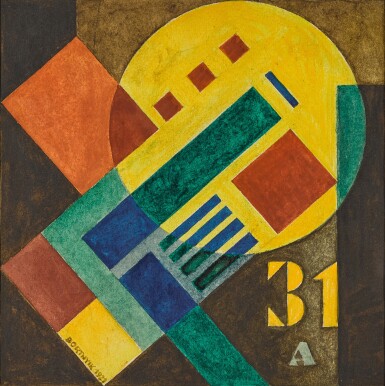
Property from a Distinguished Private Collection
Sándor Bortnyik
Untitled
Lot Closed
November 9, 02:21 PM GMT
Estimate
26,000 - 36,000 GBP
Lot Details
Description
Property from a Distinguished Private Collection
Sándor Bortnyik
Hungarian
1893 - 1976
Untitled
signed and dated BORTNYIK 1921 lower left
gouache on paper
Unframed: 17.5 by 17.5cm., 6¾ by 6¾in (image size); 28 by 19.7cm., 11 by 7¾in (sheet size)
Framed: 36.5 by 29.5cm., 14¼ by 11½in.
Private collection, Luxembourg
Sale: Kunsthaus Lempertz, Cologne, 29 November 2006, lot 38
Purchased at the above sale by the present owner
Sándor Bortnyik played an important role in the development of the Hungarian avant-garde. Like Moholy-Nagy, Bortnyik was a member of the avant-garde group connected with the magazine MA, which was published initially in Budapest and later in Vienna by Lajos Kassák. Bortnyik had studied fine art in Budapest from 1913 onwards at the Budapest Free School under Károly Kernstok and József Rippl-Rónai, and was attracted by the style of the Fauves until 1915, when he met Lajos Kassák, who invited him to become a contributor to the magazine.
In 1919, following the collapse of Béla Kun’s short-lived communist regime and the invasion of Romanian troops, Bortnyik and other artists connected with MA were forced to flee Budapest. He settled in Vienna and went on to live in Weimar from 1922 to 1924, working closely with the Bauhaus. After being forced into exile, Bortnyik began to admire Malévich’s Suprematism through the interpretations of El Lissitzky, whom he had met in Berlin in the early 1920s. His close contact with the Constructivist movements of the time gave rise to non-figurative works with a strong architectural component and prompted his permanent shift from synthetic Cubism to geometric abstraction. Even so, Bortnyik refused to be identified with the Bauhaus. During this period he also worked in Kassa (now Kosice, Slovakia) and Berlin.
Painted in 1921 as a stage design for Tanz der Tiere (Dance of the animals) the present work is related to an album of six abstract prints published by the magazine MA in Vienna in 1920, in which Bortnyik’s language had already veered towards a constructive abstraction verging on Machinism. Here, the juxtaposition of diagonals and verticals, of circles and quadrilaterals, devise a visual vocabulary that is reminiscent of the works of Malevich in his illustrated book Suprematism. 34 Drawings, published in 1920.
You May Also Like










